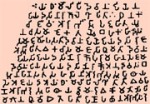Ashokan Inscriptions
 Ashoka (d.273-236BC) was one of the most successful and powerful kings whose large number of edicts came into light from in India, Nepal, Pakistan and Afghanistan. Inscribed on the rocks and the pillars they talk about the reforms in Ashoka's policies and his advice to his subjects. After Kalinga war, Ashoka repenting the blood bath had converted his religion to Buddhism.
Ashoka (d.273-236BC) was one of the most successful and powerful kings whose large number of edicts came into light from in India, Nepal, Pakistan and Afghanistan. Inscribed on the rocks and the pillars they talk about the reforms in Ashoka's policies and his advice to his subjects. After Kalinga war, Ashoka repenting the blood bath had converted his religion to Buddhism.
In the 'Bhabru Edict' he declared his faith in the Three Jewels' of Buddhism. As he went on a pilgrimage of the holy places associated with the Buddha he engraved his Dharma, i.e., the 'Law of Piety' on the rocks and pillars to spread Buddhism. The Ashokan edicts contained the fundamental principles of mastery of the sense, purity of thought, gratitude, and steadfastness of devotion, kindness, charity, purity, truthfulness, service, support and reverence.
The Ashoka's edicts have been discovered at Kalsi. Sopara, Girnar, Dhauli, Jaugada, Maski and Yeraguddi in India and at Shahbaz Garha and Mansehra in the NWFP. These are mainly concerned with the reforms and the moral principles to build a fair and humane society. The rock inscriptions reveal the propagation of Ashoka's "Law of Piety".
An ancient inscription on a large stone pillar was deciphered by James Princep In 1837 AD. The 14 edicts enunciate the leading principles of the Buddhism. The name Ashoka occurs only in the minor rock edicts at Maski and Gujarat in India. The title Devanampriya meaning 'Beloved of the Gods' and Priyadarsin meaning 'One of the Amiable Look' have appeared in the edicts at Shahbaz Garha and other places in India.
Ashoka's edicts are found in more than thirty places throughout India, Nepal, Pakistan and Afghanistan. Most of them are written in Brahmi and Magadhi language probably the official language of Ashoka's court. The average height is between 40 and 50 ft and the edicts weighs up to fifty The location of the rock edicts are found in places associated with the life of Buddha or are en route to major pilgrimage centers so that as many people as possible can read these edicts. The Lumbini pillar marks the Buddha's birthplace, while inscriptions on it commemorate Ashoka's pilgrimage to that place.
Some of the Major Architecture in Ancient & Medieval Times in India
Contribute More Facts